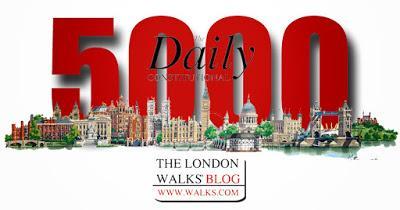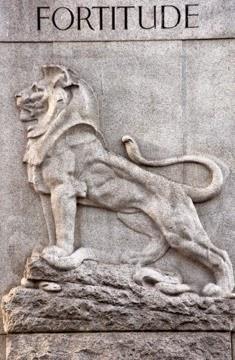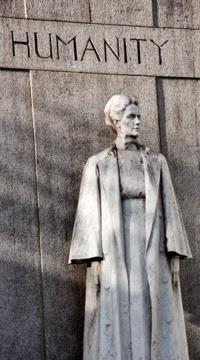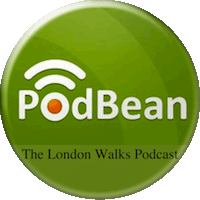 DC Editor Adam writes…
DC Editor Adam writes…In December 2016 I posted the The Daily Constitutional's blog post number 5,000.
To mark the occasion I've been digging in the archive and over February 2017 I'll be reblogging The DC's "Greatest Hits" – my 50 favorite posts.
In addition I'll be sharing my 50 favorite London photos to have appeared here since October 2008.
I hope you enjoy them
A.S-G
London
Feb 2017
London Walks Pen & Daily Constitutional Special Correspondent David Tucker pauses by a statue hidden in plain view. This post was first published in May 2015…

Fast by, pass by. It’s like Junk Food, it’s empty calories.
Talking about the Edith Cavell statue on William IV Street, just up from Trafalgar Square. And talking about the hordes who are right there, day in and day out – who miss it, walk on by. Miss seeing something absolutely extraordinary. A woman, right there, being executed by firing squad.
Jesus.
How do you not see that?
But they don’t. They come out of Pret, blind to it even though it’s right in front of them. Or ignore it on their way to Leicester Square Tube. Or tunnel vision past it on their way to Trafalgar Square.
They miss it.
A woman’s being executed right there – right by them – and they miss it.
They mindlessly wander and stroll and surge and flit past it, the hordes. Paying it no regard whatsoever. Well, maybe a few of them give it an idle, passing glance. A passing glance that amounts to dipping for water with a sieve.
More’s the pity. Because they’re, well, “losers” – they’re losing out.
And no, I’m not being a carnival barker, not spieling “step right this way, see a woman drilled full of lead by a firing squad.”
What I am saying is you should take aim at the Cavell statue. Take aim with your intelligence, your imagination and indeed your self-respect.
For lack of a better word, it pays to do so. It’s enlarging, enriching.
Ready, aim…
This image first.

Cavell has her back to the wall. Literally and figuratively. She’s about to be shot. She’s facing her firing squad. She’s looking at them. But she’s also looking slightly to the left. In the general direction of Brussels. In the general direction of the dawn. And indeed that slight turn of the head to her left directs us – well, it should direct us – to the single word on the east side of the statue: Sacrifice.
And notice the word above her head: Humanity. That firing squad isn’t just gunning her down. It’s taking aim at “Humanity”.
The four words round the plinth – one on each face – are of course set in stone (so to speak), but they’re also, in a sense, akin to the Times Square Digital Ticker Tape. One leads on to another. They go through our mind, scroll past our mind’s eye. They’re connected, conjoined.
The four are: Devotion. Humanity. Sacrifice. Fortitude.
Sacrifice “faces” east, faces dawn, faces Brussels. Where Cavell was shot at dawn.
Fortitude is at the back. Going round the statue and seeing the word there is chilling. You look at it and you’re thinking of her standing there, facing her firing squad and the bullets hitting her and tearing through her and ripping out of her back. Drilling through the stone, through that word Fortitude, toward us, standing there, in the line of fire, with just Edith Cavell and the plinth and that word Fortitude between us and the line of fire. And Cavell’s courage. Her fortitude.
And round it goes again. Devotion. Humanity. Sacrifice. Fortitude.
What else? Well, there’s what she said in that last letter – you can read it there, beneath the Brussels Dawn October 12, 1915 inscription – “Patriotism is not enough, I must have no hatred or bitterness for anyone.”
Time now to do a U turn and go right up the monument. Up past Cavell. Past the word Humanity. Past the For King and Country inscription. See what it does there? There’s sort of a cross there. And on the drapery – the drapery that echoes Cavell’s garment – there’s a Geneva cross. A red cross.
And then the woman and the child. Who are they?

They’re also facing that firing squad. Especially the child. See how the child is frightened. Who wouldn’t be?
The woman – shrouded, there’s more than a hint of a mourning veil in that garment – represents Humanity. The child represents small states. The woman is protecting the child. Humanity is protecting small states – like Belgium.
Germany’s invading Belgium was of course the casus belli for the British declaration of war.
But the statue – like all of its patriotic kin – is taking the high ground. There’s so much more to the question. There’s Belgium’s virtually being the creation of the 19th century British Foreign Minister Palmerston and his deep dyed sense of Realpolitik – seeing the Belgian coast as virtually the coast of England and wanting to make sure that it wasn’t the England-facing sword edge of a great continental power like France or Germany. And indeed, in the matter of that “small state’ – poor little Belgium – well, ask the Congolese how they felt about King Leopold and his harmless, innocent little state.
Anything else? Oh, yes. For sure.
There’s this chap.

Notice the direction he’s facing. East. Toward Brussels. Toward the Kaiser’s Germany.
Notice his lashing tail. He’s angry. He’s going to do something about what he doesn’t like the look of.
He pretty well sums up how the British people felt about the outrage that took place at dawn, in Brussels, on October 12, 1915.

Why was Edith Cavell executed? She was running a clinic and nurse’s training school in Brussels. She was helping British soldiers to escape. They were often disguised as patients. The Germans became suspicious. They began to pay “visits” to the clinic.
Cavell was arrested on August 5. Along with several others. She was put in solitary confinement. She made a statement. It amount to a confession. It named some of her accomplices. On October 7 nine people were court martialled. Five were found guilty of assisting the enemy and damaging the German war effort. They were sentenced to death. Their four co-defendants to hard labor. The death sentences of three of the condemned were commuted. But not Cavell’s or Phillip Baucq’s (he was the leader of the resistance movement).
Anything else? Sure, it’s London. There’s always something else. In this instance four odds and ends. For good measure.
1. The statue was unveiled by Queen Alexandra on March 17, 1920. Danish by birth, Alexandra loathed her nephew, Kaiser Wilhelm. Edward VII’s Queen Consort, she was a throwback to “before” – to the Victorian and Edwardian era. To before the fall – to the Indian summer of the Pax Britannica. To those golden days before the unmitigated horrors of the Great War were loosed upon western civilization. And it was just nine months after the blame game had reached its apotheosis in the disastrous Treaty of Versailles. In 1920 there were untold pathogens coursing through the body politic of Britain – and indeed of every other war participant, be they victors or losers – and the statue’s implied “message” – “we’re humanity, the Germans are inhuman” – is a crystallisation of those pathogens.
2. Edith Cavell’s final resting place is just outside Norwich Cathedral. Much of her working life was in London and Brussels but she grew up in Norfolk.
3. Her dog, Jack, a Jack Russell terrier, became an exhibit at the Imperial War Museum.
4. The sculptor was Sir George Frampton. Either he just knew – or someone taught him – how to jump on the wind’s back and take it where it will. Away he went with this Edith Cavell monument. And away he went – second star to the right and straight on to Kensington Gardens, to Never Never Land – where his sculpture of Peter Pan is forever eluding the ticking crocodile.
A London Walk costs £10 – £8 concession. To join a London Walk, simply meet your guide at the designated tube station at the appointed time. Details of all London Walks can be found at www.walks.com.











